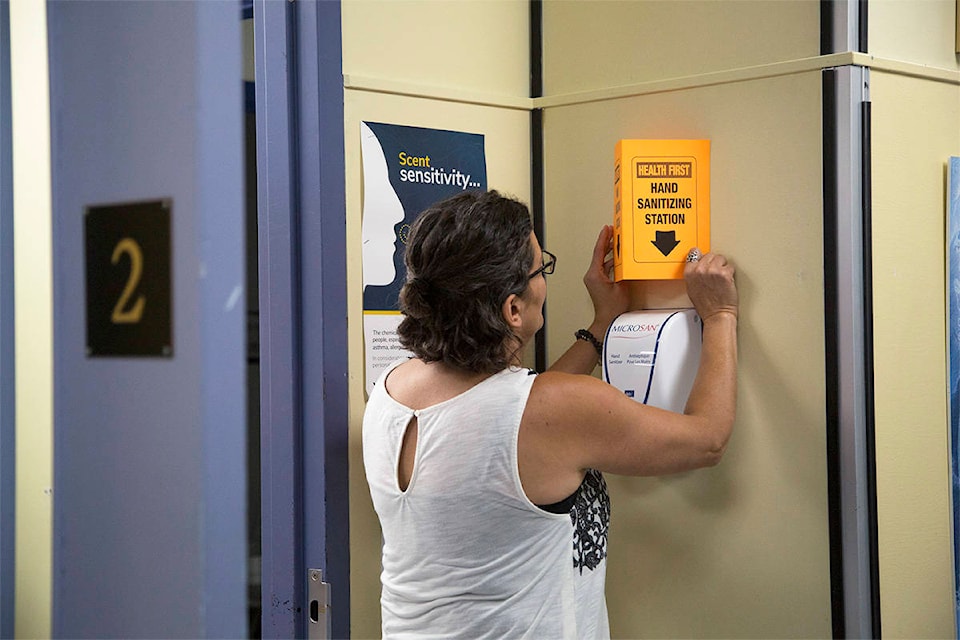Schools across the Yukon are preparing to welcome students back with new COVID-19 operating plans that detail everything from handwashing to which entrances students should use.
“Certainly it’s very busy, there are a ton of loose ends being tied up in the next week or so. But I would say all of that is overshadowed by just how excited that I and the rest of our staff are to see our kids face to face again in the school,” said Ryan Sikkes, the principal of Vanier Catholic Secondary School.
While some schools with at-capacity populations had to shuffle students, Vanier did not. But like other high schools across the territory, Grade 8 and 9 students will attend full-day class, while Grade 10, 11 and 12 students will attend half-day classes.
That presents challenges, but also opportunities for flexible learning, according to Sikkes.
“Many of us are going to be feeling a lot like first-year teachers, you kind of just need to learn how things work and how you’re going to make it work,” he said.
He said students will be able to access technology and study spaces in the school. Unlike in March, when the school year was abruptly cut short, students will have face-to-face contact with teachers daily.
“There will be way more opportunities to make sure that kids are not falling behind or falling through the cracks than there was in the spring,” he said.
Jeff Cressman, principal of Elijah Smith Elementary, said teachers are receiving training on how to speak to younger grades about COVID-19 and encourage physical distancing and handwashing.
“I’m not saying it’s going to be easy, but when you start off a school year, the kids come in and spend the first two weeks kind of going over what school is all about anyways. So this would just be another added layer,” he said.
“The idea is to talk to them and not make it a scary thing. It’s not a reason to be afraid to come to school, it’s just that we’re doing this so everyone can be healthy.“
Cressman said he’s had conversations with parents who were anxious due to a lack of information, but he believes the new COVID-19 operational plan for the school should ease concerns.
“It should answer a lot of their questions,” he said.
Despite that assurance, Yukon Party education critic Scott Kent said some members of the community are still waiting for more detailed answers.
Kent said he’s not satisfied with the information the Yukon government has provided teachers and parents, particularly around busing and the pressure facing teachers to deliver a curriculum while keeping classrooms safe.
“Communication has been less than stellar,” Kent said. “I think parents and teachers were looking for more timely communications, to make efforts to get information out the door in a more timely and detailed way. There was an awful lot of work that should have been done earlier in the process.”
Kent said he wants to see more details about the specifics of the study halls, including how many students will be present. He said it’s still not clear how the half-day schedules will affect senior students, particularly with mid-day transportation. High school bus schedules are not yet available.
“We have to find a way to make sure that what is put in place doesn’t make us take a step backward. The worst-case scenario would be if for some reason the schools had to shut down again,” he said.
Yukon Teachers Association president Ted Hupé said that despite a tremendous amount of work by teachers and government, there are plenty of questions that won’t have answers until the school year begins.
Numbers in classrooms are still changing, as parents review plans and make final decisions about enrolment. Some families will opt out of classroom learning, while others will have no choice.
He said some teachers may also be facing difficult personal choices around balancing their health with their profession. Many of Yukon’s substitute teachers are in their 50s and 60s and face a greater health risk from COVID-19, which could cause shortfalls if they decide to step back from teaching.
The pace for preparations has been breakneck since late July.
For example, COVID-19 operational plans for classrooms were released to teachers on the same day they were made public, meaning educators have only been given five days to provide feedback and prepare before students arrive.
In addition, those plans became outdated as they were released, with the government issuing new recommendations the same day about children wearing masks on buses and in busy corridors.
Hupé said teachers concerned about health and safety were happy with the revised recommendation, but it illustrates that many things may continue to change as schools adapt to pandemic teaching.
“There’s going to be things that happen between now and the middle of September that we may not have anticipated. We’re going to try to adapt, we’re going to try to have our plans, but be flexible enough so that we can improve,” he said.
“We’re all trying to get to the same place. We’re trying to get schools up and running, we’re trying to make them safe and we’re trying to build confidence in the system for everyone: kids, parents and teachers,” he said.
Contact Haley Ritchie at haley.ritchie@yukon-news.com
